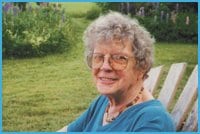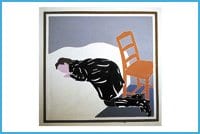Painter and print-maker Erica Rutherford had a rich and incredibly varied life journey. Few can pack as much into one lifetime as Rutherford did. As her autobiography’s title suggests — Nine Lives — Rutherford could sincerely lay claim to having led several different lives. She had serious stints as a visual artist, an actor, a film producer, a business owner, a teacher and a writer.
She was born Eric Rutherford on Feb 1, 1923 in Edinburgh, Scotland, the youngest of four children; she died at the age of 85 on Apr 11, 2008 in Charlottetown, Prince Edward Island. Rutherford leaves behind her life partner, Ambika Gail Rutherford, whom she initially met in London in 1959, and their daughter Susana.
One of Rutherford’s very first lives was growing up male; she didn’t relate to the assigned role. In her early life Rutherford relied on acting abilities to perform gender and to create a masculine persona. An increasing sense of self-awareness and anguish often led unsupportive psychiatrists to misdiagnose Rutherford as a repressed homosexual. At the time there was no such clinical diagnosis as gender dysphoria. In Nine Lives Rutherford recounts that it wasn’t until the 1960s that the medical establishment even acknowledged that gender confusion could, or did, exist. It wasn’t until 1976, when Rutherford was in her 50s, that she had sex reassignment surgery.
Seemingly never one to settle, Rutherford lived in several countries around the world. She lived in and around England, Spain, the US midwest, South Africa, Toronto and finally permanently moved to Prince Edward Island in 1985. One of her lives included farming and working as a film producer in Africa. Remarkably in 1949 Rutherford produced a film titled Jim Comes to Jo’Burg, or alternately, African Jim, along with director Donald Swanson. African Jim was the first feature film from South Africa with an all-native African cast. Featuring local musicians and actors, African Jim showed audiences people they had never before seen on the big screen. An admirable move, especially given that apartheid was just settling in.
As a writer Rutherford’s books were published by PEI’s now-defunct Ragweed Press. In 1988 under the pseudonym Talia Katasanda, she wrote and illustrated Yoga for Cats, her most popular book which has spawned countless remakes and variations by other authors. She also wrote An Island Alphabet which is largely a collection of paintings. Alphabet is an artistic documentary of life on Prince Edward Island; vibrant and colourful, it demonstrates Rutherford’s affinity for outdoor living.
As a visual artist Rutherford started the Printmakers Council of PEI. The council started organically at her studio in Pinette, where she invited artists to visit and work. The council grew and moved to its own space in Charlottetown. Having lived for a time in Toronto she was involved in the printmaking community at Open Studio, where her work is still available.
Rutherford was admitted to the Royal Canadian Academy of Artists in 1999, and has work in the Canada Council Art Bank, the Arts Council of Great Britain, the Island Art Collection of the Government of PEI and the Museum of Modern Art in New York. She had solo exhibitions in England, Spain, Colombia, San Francisco, Chicago, Toronto and Halifax to name a few. Her last show was at the Confederation Centre Art Gallery, a federal museum in Charlottetown.
Donations to a scholarship fund in Rutherford’s name are being accepted by the PEI Council of the Arts.


 Why you can trust Xtra
Why you can trust Xtra


